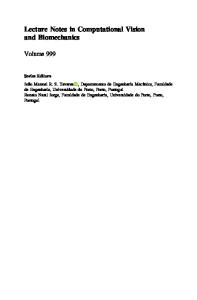Biomedical Imaging and Computational Modeling in Biomechanics
This book collects the state-of-art and new trends in image analysis and biomechanics. It covers a wide field of scientific and cultural topics, ranging from remodeling of bone tissue under the mechanical stimulus up to optimizing the performance of sport
- PDF / 7,196,192 Bytes
- 207 Pages / 439.37 x 666.142 pts Page_size
- 103 Downloads / 343 Views
Editorial Advisory Board Alejandro Frangi, University of Sheffield, UK Chandrajit Bajaj, University of Texas at Austin, USA Eugenio On˜ate, Universitat Polite´cnica de Catalunya, Spain Francisco Perales, Balearic Islands University, Spain Gerhard A. Holzapfel, Royal Institute of Technology, Sweden J. Paulo Vilas-Boas, University of Porto, Portugal Jeffrey A. Weiss, University Of Utah, USA John Middleton, Cardiff University, UK Jose M. Garcı´a Aznar, University Of Zaragoza, Spain Perumal Nithiarasu, Swansea University, UK Kumar K. Tamma, University Of Minnesota, USA Laurent Cohen, Universitı´ Paris Dauphine, France Manuel Doblare´, Universidad De Zaragoza, Spain Patrick J. Prendergast, University Of Dublin, Ireland Rainald Lohner, George Mason University, USA Roger Kamm, Massachusetts Institute of Technology, USA Thomas J.R. Hughes, University Of Texas, USA Yongjie Zhang, Carnegie Mellon University, USA Yubo Fan, Beihang University, China
For further volumes: http://www.springer.com/series/8910
Lecture Notes in Computational Vision and Biomechanics Volume 4
This book is the first to be published under the Book Series “Lecture Notes in Computational Vision and Biomechanics (LNCV&B)”. The research related to the analysis of living structures (Biomechanics) has been a source of recent research in several distinct areas of science, for example, Mathematics, Mechanical Engineering, Physics, Informatics, Medicine and Sport. However, for its successful achievement, numerous research topics should be considered, such as image processing and analysis, geometric and numerical modelling, biomechanics, experimental analysis, mechanobiology and enhanced visualization, and their application to real cases must be developed and more investigation is needed. Additionally, enhanced hardware solutions and less invasive devices are demanded. On the other hand, Image Analysis (Computational Vision) is used for the extraction of high level information from static images or dynamic image sequences. Examples of applications involving image analysis can be the study of motion of structures from image sequences, shape reconstruction from images and medical diagnosis. As a multidisciplinary area, Computational Vision considers techniques and methods from other disciplines, such as Artificial Intelligence, Signal Processing, Mathematics, Physics and Informatics. Despite the many research projects in this area, more robust and efficient methods of Computational Imaging are still demanded in many application domains in Medicine, and their validation in real scenarios is matter of urgency. These two important and predominant branches of Science are increasingly considered to be strongly connected and related. Hence, the main goal of the LNCV&B book series consists of the provision of a comprehensive forum for discussion on the current state-of-the-art in these fields by emphasizing their connection. The book series covers (but is not limited to): l
l l l l l l l
l
l l l l l l l
Applications of Computational Vision and Biomechanics Biometri
Data Loading...











